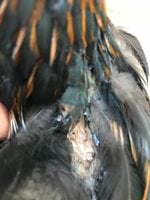We've got 4 hens, they're almost a year old. About a month ago 2 of them stopped laying abruptly. Eventually I found lice on one of them (an EE). We treated all 4 birds and their living space. With the other non-layer, a Black Star, I never saw any bugs on her, but she had a lot of father loss around her vent and on her neck. And all the skin around her butt was bright red.
I've been spraying her butt with a healing poultry wound spray. And it looks like new feathers are growing on her neck. But the skin on her neck doesn't look like any chicken skin I've ever seen. The woman at our local feed store said it looks fine, but couldn't tell me why it didn't look like normal skin. I've never had major feather loss before, is this just what skin looks like as feathers grow?
I took this pic a few days ago. The skin looks even drier and flaky-er now. Sorry, I know it might be hard to see in a picture. I can try to get a better picture tomorrow.

I've been spraying her butt with a healing poultry wound spray. And it looks like new feathers are growing on her neck. But the skin on her neck doesn't look like any chicken skin I've ever seen. The woman at our local feed store said it looks fine, but couldn't tell me why it didn't look like normal skin. I've never had major feather loss before, is this just what skin looks like as feathers grow?
I took this pic a few days ago. The skin looks even drier and flaky-er now. Sorry, I know it might be hard to see in a picture. I can try to get a better picture tomorrow.




